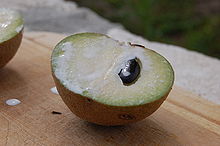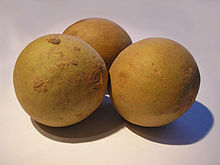Manilkara zapota: Difference between revisions
| Line 42: | Line 42: | ||
*[[Black sapote]] |
*[[Black sapote]] |
||
*[[Mamey sapote]] |
*[[Mamey sapote]] |
||
hello!! |
|||
==External links and references== |
==External links and references== |
||
Revision as of 18:55, 24 September 2008
| Sapodilla | |
|---|---|

| |
| Sapodilla tree | |
| Scientific classification | |
| Kingdom: | |
| Division: | |
| Class: | |
| Order: | |
| Family: | |
| Genus: | |
| Species: | M. zapota
|
| Binomial name | |
| Manilkara achras (L.) P. Royen
| |
Sapodilla (Manilkara zapota) is a long-lived, evergreen tree native to the New World tropics. It is a native of Mexico and was introduced to the Philippines during Spanish colonisation.

Description

Sapodilla grows to 30-40 m tall. It is wind-resistant and the bark is rich in a white, gummy latex called chicle.
The ornamental leaves are medium green and glossy. They are alternate, elliptic to ovate, 7-15 cm long, with an entire margin.
The white flowers are inconspicuous and bell-like, with a six-lobed corolla.
The fruit is a large globose berry, 4-8 cm in diameter, very much resembling a smooth-skinned potato and containing 2-10 seeds. Inside, its flesh ranges from a pale yellow to an earthy brown color with a grainy texture akin to that of a well-ripened pear.
The flavour is exceptionally sweet and very tasty. The fruit's flavor has been compared to cotton candy or caramel. The unripe fruit is hard to the touch and contains high amounts of saponin similar to tannin which dry out the mouth.
The seeds are black and resemble beans, with a hook at one end that can catch in the throat if swallowed.
The sapodilla trees yield fruit twice a year, though flowering may continue year round. The fruit has a high latex content and does not ripen until picked. Some are round and some are oval with pointed ends.


Other Names
Sapodilla was formerly often known by the invalid name Achras sapota. It is known as chikoo or sapota in India, sofeda in Eastern India & Bangladesh, chikoo (also spelled "chikku," "चिक्कू," "chiku," "चीकू," or "ciku") in South Asia and Pakistan, chico in the Philippines, sawo in Indonesia, ciku in Malaysia, hồng xiêm (xa pô chê) in Vietnam, sapodilla in Guyana sapodilla or rata-mi in Sri Lanka, lamoot (ละมุด) in Thailand and Cambodia, níspero in Colombia, Nicaragua, El Salvador, Dominican Republic and Venezuela, nípero in Cuba and Dominican Republic, dilly in the Bahamas, naseberry in the rest of the West Indies, and sapoti in Brazil. In Kelantanese Malay, the fruit is called "sawo nilo" which is closer to the original name than the standard Malay "ciku".
See also
hello!!
